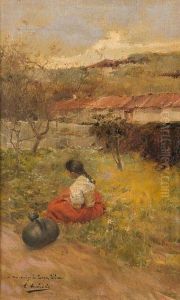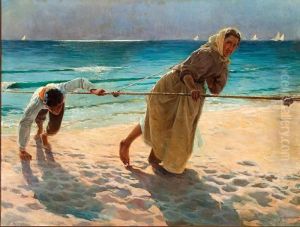Angel Andrade Blasquez Paintings
Ángel Andrade Blázquez was a prominent Spanish painter, born on November 26, 1866, in Ciudad Real, Spain. His early life was marked by a keen interest in the arts, which was nurtured and supported by his environment and education. Andrade's artistic journey began in his hometown but soon extended to Madrid, where he furthered his studies at the Real Academia de Bellas Artes de San Fernando, one of the most prestigious art schools in Spain. His time at the academy was crucial for his development, allowing him to refine his skills and forge important connections in the art world.
Andrade's work is often categorized within the Spanish realist tradition of the late 19th and early 20th centuries, but he also explored impressionism and symbolism. His oeuvre includes a wide range of subjects, from landscapes and urban scenes to portraits and historical themes, demonstrating his versatility and keen observational skills. Andrade was particularly adept at capturing the effects of light and atmosphere, a skill that imbued his landscapes with a sense of immediacy and vitality. His paintings are characterized by their subtle color palettes, meticulous detail, and the emotional depth of their subjects.
Beyond his contributions to painting, Ángel Andrade was also an esteemed educator and played a significant role in the cultural life of Spain. He held a professorship at the Real Academia de Bellas Artes de San Fernando, where he influenced a new generation of artists with his teachings and philosophy. Andrade's commitment to art was not just limited to his own creations but extended to his efforts in nurturing and advocating for the arts within the broader Spanish society.
Ángel Andrade Blázquez's legacy is marked not only by his remarkable body of work but also by his impact on the Spanish art scene of his time. His paintings are held in high regard and can be found in various museums and private collections across Spain and beyond. Andrade passed away on February 15, 1931, in Madrid, leaving behind a rich legacy that continues to be celebrated for its artistic integrity and contribution to Spanish culture.




